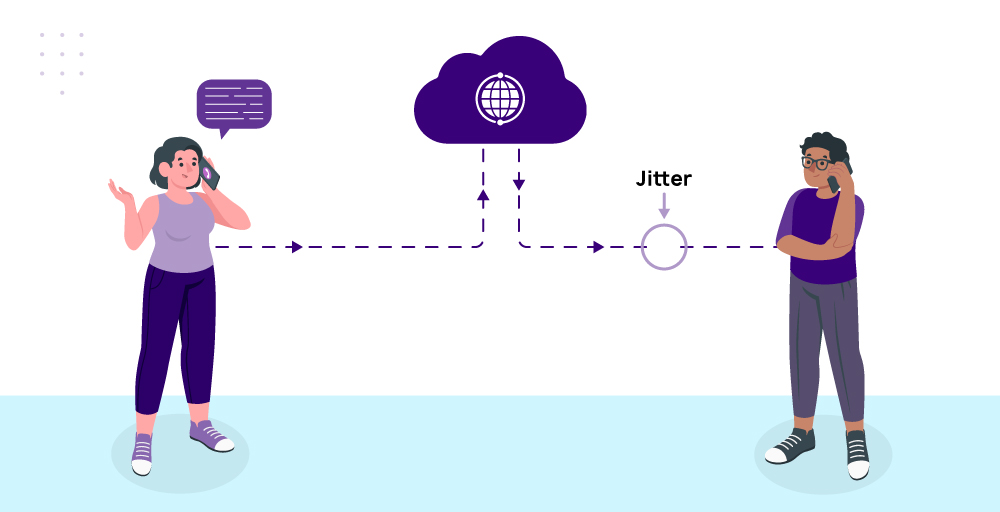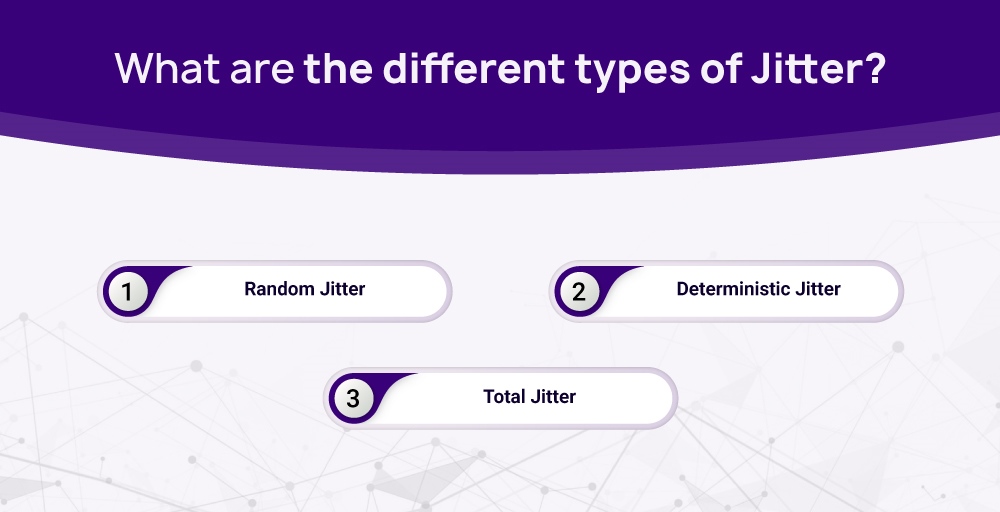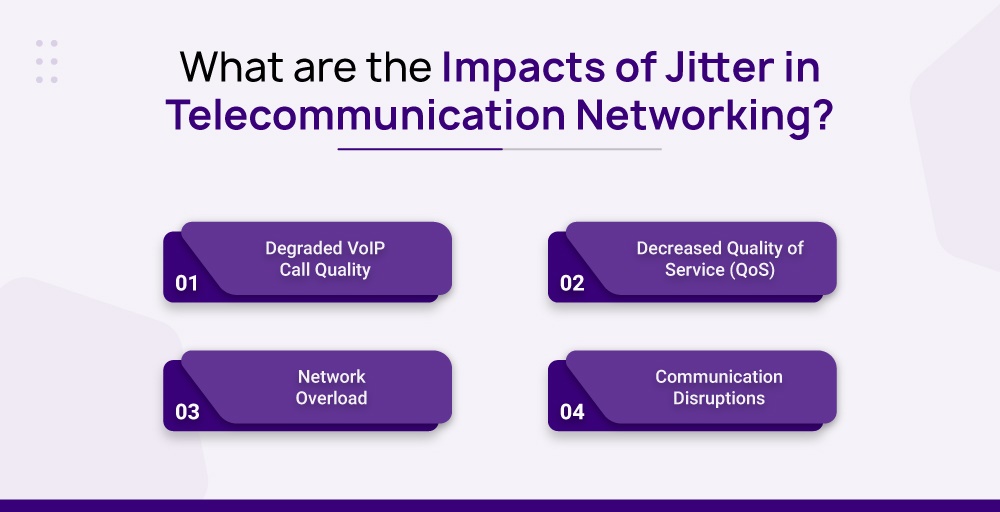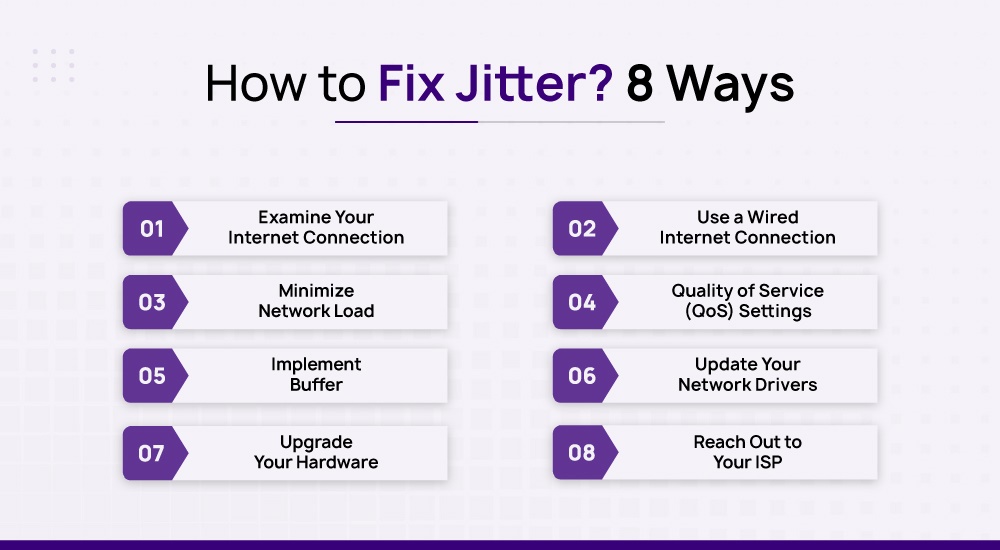Have you ever experienced the irritation of choppy audio calls or laggy online games? Or have you ever been on a video call where your voice starts to stutter like a malfunctioning robot? 😖
If so, then you might be pretty familiar with the silent disruptor, JITTER. It is the culprit behind all those choppy and frustrating interactions.
In this blog, we are going to explore more about what is jitter, its causes, the havoc it wreaks, and most importantly, its solution to restore smooth and uninterrupted online experiences.
🔑 KEY POINTS
- Jitter, latency, and ping all may sound similar, but each of these networking terminologies has its own meaning.
- There are three types of jitters: random jitter, deterministic jitter, and total jitter.
- Ideally, the acceptable jitter for VoIP is 30 milliseconds.
- Some of the ways to troubleshoot jitter include reducing network traffic, implementing buffers, keeping your network drivers up-to-date, and increasing your bandwidth.
What is Jitter?
A jitter is a delay or fluctuation in the flow of data packets between two systems over a network. In simpler terms, it is an unevenness in the timing of information when it travels from one computer to another, especially while communicating over the internet.

Jitter is like a hiccup for signals, an interruption in digital communication. Its impact varies, from causing you mild frustration to even disrupting a whole connection of your network.
A very common example of jitter is the freezing or lagging of a video during a video call. Or you have probably witnessed that sometimes the voices don’t match the lip movements of the video. Or the occasional skips, pauses, and stutters of audio while on call. All of these are some of your day-to-day experiences of facing a jitter.
What causes jitter?
While communicating over a digital network, the sender usually sends data packets at a regular interval of time. Likewise, when there’s a delay or variation in the timing of sending those RTP data packet streams, it causes jitter.
Various factors lead to network jitter, some of which are:
- Network Traffic: When several devices are in a sole network waiting in a queue at various points of the communication channel, each consuming bandwidth can cause a congested network. This leads the network to overcrowding, causing data streams to be held up, resulting in jitter.
- Poor hardware: Outdated and low-quality hardware like routers, switches, Ethernet cables, oscillators, and unstable clocks leads to variations in signal timing. This leads to irregularities and disruptions in the transmission of data signals.
- Packet Priority Failure: For specific systems like VoIP, where audio data should be prioritized over others, failure in implementing techniques like packet prioritization can cause excessive jitters.
- Electrical disturbances: Electromagnetic interference (EMI) and several environmental electromagnetic noises can fluctuate and disrupt the precise timing of the signal, causing a jitter.
What are the different types of Jitter?

1. Random jitter (Gaussian jitter)
Random jitter is an unpredictable variation in the timing of a signal due to some clock glitches, thermal noise, or other random electronic timing noise in a circuit. It is also called a Gaussian jitter because the statistical variation of its timing delay typically follows a normal distribution or a bell-shaped curve.
2. Deterministic jitter
In electronics, the data signal jitter that is predictable and reproducible is known as a deterministic jitter. The minimum and maximum extent of this kind of jitter is bounded, i.e., the peak-to-peak value is defined. Therefore, it is also known as bounded jitter.
3. Total jitter
Total jitter is the combination of random and deterministic jitter. It’s computed in the context of a required bit error rate (BER) for the system. A common BER used in common standards such as ethernet is 10^-12.
What is an Acceptable Jitter for VoIP?
The acceptable jitter for VoIP is below 30 milliseconds. This keeps packet arrival consistent enough for your voice to flow naturally.
However, it’s not a hard and fast rule. Jittering up to 40 ms might be tolerable for short periods, but anything beyond that can become increasingly disruptive. Jitter can bring a lot of problems in VoIP call quality. Remember, the lower the jitter, the smoother your call.
Jitter Vs Latency Vs Ping: What is the difference?
Jitter, latency, and ping all of them are related to network and data transmission, so they might sound similar, but in reality, all of them are different from each other.
Latency
- Latency is the overall time taken by your data to travel from one point to the other, generally from your device to the server.
- It affects the overall responsiveness. High latency leads to noticeable delays in loading websites, streaming videos, or downloading files.
- For example, while downloading a file, latency determines the estimated time of successful download.
Jitter
- Jitter is the overall variation and fluctuation in latency over time.
- It impacts the smoothness and consistency of data flow. Even with decent latency, maximum jitter can cause laggy video and choppy audio.
- For example, while downloading a file, jitter stutters the download, slowing things down.
Ping
- Ping is the overall time for a round-trip latency, i.e., the time it takes for data to travel from your device to the server and then the response from the server to your device.
- It provides a specific representation of RTT (round-trip time) to a particular server. This helps diagnose connectivity issues of online services.
- Ping doesn’t determine anything related to downloading a file, it’s like clicking the download file button and waiting for the server’s response to start downloading.
What are the impacts of jitter in telecommunication networking?
Jitter has various negative impacts on telecommunication networking, some of them are as follows.

Degraded VoIP call quality
Jittering causes choppy videos, laggy and stuttering audio, and problems in video-audio syncing. Additionally, in some cases, jitters garble the audio stream, making the phone echo and sound robotic. This degrades the overall call quality of the VoIP system.
Decreased Quality of Service (QoS)
The impact of jitter in QoS is significant, resulting in a frustrating and disappointing experience for a user. The decrease in call quality, such as dropped calls, data errors, and delayed responses, leads to miscommunication, annoyance, and irritation, decreasing the overall quality of service (QoS).
Network Overload
With low bandwidth and jitters, data transactions become slow, resulting in overloaded network traffic. Devices like routers use buffers to store the data streams temporarily, with the jitters, the arrival of data packets varies, causing buffer overflows. This issue leads to increased latency and packet loss, harming the overall communication.
Communication Disruptions
Jitters disrupt the flow of communication or even cause a complete loss of connection (in some cases). In systems like online gaming and VoIP, unpredictable lags, distorted visuals, stuttering, and freezing make communication unresponsive, affecting performance.
How to measure network jitter?
To measure network jitter, you can use one of these ways:
Single Endpoint
If you don’t have control over multiple endpoints, you can still use only a single endpoint to measure your network jitter by implementing a ping jitter test. To do so, you have to send a series of packets to a remote server.
Generally, the ping command is used for this purpose. Then, measure the variation in round-trip times (RTT) between packets. Typically, jitter is the average deviation from the mean RTT.
Double endpoint
Having overall control of the network and using the double endpoint method gives you a more accurate measure of your network jitter. This method involves measuring the instantaneous jitter.
To do so, you can use specific networking tools like Wireshark to calculate the variation between the intervals for each end-point (transmitting and receiving) of a single data packet.
Bandwidth Testing
Along with metrics like download speed, upload speed, and ping time, you can also measure the jitter of your network by performing a bandwidth test. This is basically used to measure the data transfer rate within a given interval of time.
Bandwidth testing tools usually send continuous streams of data packets and measure jitter on the basis of the variation in interval time.
8 ways to fix jitter
Due to its unpredictable nature and tricky solutions, troubleshooting jitter can be a bit of a confusion for you.

Fixing a jitter in your network may involve various measures and steps varying according to the cause behind it.
1. Examine Your Internet Connection
First, make sure your internet connection is in good working condition. You can perform a bandwidth test or speed test to check the quality of your internet connection. The jitter could be because of high latency or low bandwidth. If this is the case, get rid of unnecessary bandwidth usage to reduce the jitter of your network.
2. Use a wired internet connection
Sometimes, wireless networks or WiFi can face connection and bandwidth problems because of network traffic and distance from the router. Additionally, wireless connections are more vulnerable to environmental electromagnetic interference.
Therefore, make sure to switch to a wired connection, as they can provide a more stable and reliable connection, which can help reduce jitter.
3. Minimize Network Load
Network congestion is one of the major causes of jittering. Therefore, minimizing the network traffic is another way to fix jitters. Reduce heavy users of the network or try to connect them using ethernet; this helps to take the load off your router. Likewise, you can upgrade your router’s firmware or use a powerful router to improve performance and minimize jitter.
4. Quality of Service (QoS) Settings
Using the Quality of Service (QoS) setting in your router can help prioritize certain types of traffic to reduce jitter for those applications. You have to log into your router’s interface, look for the QoS settings, and enable them. Use it to give higher priority to the applications that you want the most. This helps to minimize unnecessary bandwidth usage.
Additionally, if necessary, you can disable SIP passthrough as it can cause chaos with VoIP calls. So, disabling it can help stop jitter or your VoIP calls.
5. Implement Buffer
A jitter buffer is a type of memory installed in network systems that intentionally delays the incoming data packets and stores them temporarily to make data flow streamlined. Implementing a buffer to your system essentially introduces a small amount of latency but that by itself gives some protection against jitter.
The implementation steps of the buffer vary depending on your specific use cases and the tools you’re using. Therefore, make sure to go through specific documentation for clear and concise instructions.
6. Update Your Network Drivers
Network drivers work as the bridge between your operating system and your network hardware. So, if your network drivers are outdated or not functioning properly, it leads to communication flaws between the OS and hardware, resulting in problems like jitter.
To update your network drivers, you can update your OS as a whole. Generally, OS updates come along with updated versions of network adapters and other drivers. Or, you can update them manually using Device Manager or other third-party tools.
7. Upgrade Your Hardware
Poor hardware performance can disrupt the steady stream of data packets, causing jitters. Therefore, upgrade to high-quality hardware like powerful routers, switches, fiber optic ethernet cables that can handle large traffic and provide a stable connection. This helps to improve clock synchronization, reducing jitter.
8. Reach Out to Your ISP
If you’ve tried all other methods and are still experiencing jitters, reach out to your ISP (Internet Service Provider). You can contact customer support or request a service check for your ISP.
Additionally, if your current internet plan doesn’t provide enough bandwidth to handle your network usage, you might need to contact the ISP and upgrade to a higher plan.
Avoid Jitter by Choosing a Reliable VoIP like Krispcall
If your VoIP system faces jitter, then the problem may lie in the VoIP provider itself. You can switch to a more reliable communication platform like KrispCall, which offers 99.99% uptime. Additionally, its 24/7 human support makes it more consistent and less prone to network issues and glitches, helping you avoid jitter.

KrispCall also provides an extended set of features that involves CRM integrations, IVR (Interactive Voice Response), call analytics, and monitoring, along with providing virtual numbers. With KrispCall, you not only reduce your jitter but take your communication to a whole new level.
Conclusion
A jitter is just a variation in the flow of streams of data that causes lags, stutters, and choppiness in videos and audio while communicating. Its impacts range from giving you a mild annoyance to a complete shutdown of the network connection.
Therefore, solving jitter problems becomes crucial. To reduce the network jitter, you can apply several measures like implementing buffers, minimizing network load, using wired connections, and updating your network devices.
Additionally, you can upgrade your VoIP telephony to a more reliable system like KrispCall at a budget-friendly cost.
Why wait? Get started with KrispCall to avoid jitters and other network glitches.
Book a free KrispCall’s demo now!
FAQs
What is a WiFi jitter?
WiFi jitter is the variability in the delay of data packets traveling between a device and a network over a WiFi connection. In other words, it measures the inconsistency in the time it takes for data to travel from the source to the destination over WiFi.
Why is my jitter so high?
There may be several reasons behind your high jitter. Some of the factors that may cause your jitter to be so high include using wireless networks, traffic congestion, electromagnetic interference, low bandwidth, far distance from your router, or any other poor hardware problems.
What happens if the jitter is high?
If your jitter is high, then you may face numerous problems like choppy audio, laggy video while calling, inconsistency or frozen gameplay, and overall inconsistent data transmission.
Is high or low jitter better?
Low jitter is better, especially for real-time applications where consistent and low-latency communication is crucial. Low jitter is tied with a smoother and more reliable experience for activities such as voice and video calls, online gaming, and other real-time communication.
What is the tool to test jitter?
Several tools can be used to test jitter, and they often come bundled with network testing or monitoring software. One common tool is Ping. Other dedicated jitter testing tools include PRTG Network Monitor, StarTrinity jitter, Wireshark, Iperf, and many others.





